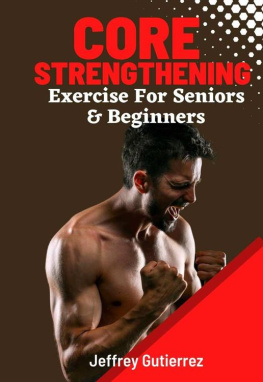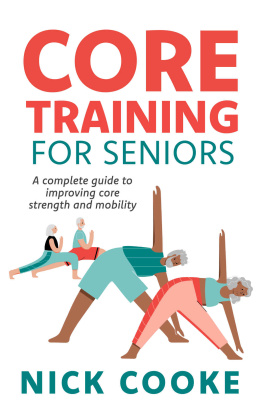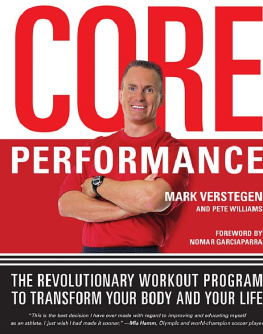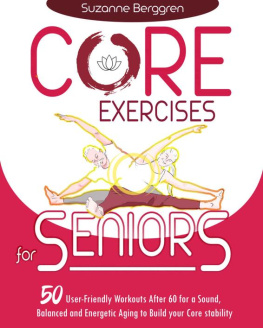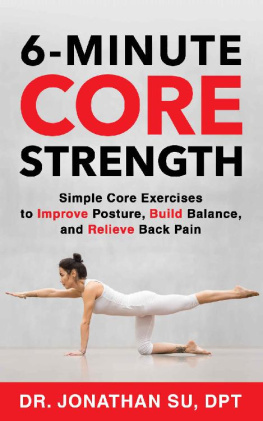Title:
Core Exercises
For Seniors and Beginners
Subtitle
Daily Routines to Build Core Strength for Safely Toning Ab, Back, and Oblique Muscles To Enhance Balance, Boost Confidence, and Boost Energy.
Copyright 2022 by ( Jeffrey Gutierrez )
All rights reserved. No part of this publication may be reproduced, distributed, or transmitted in any form or by any means, including photocopying, recording, or other electronic or mechanical methods, without the prior written permission of the publisher, except in the case of brief quotations embodied in critical reviews and certain other non-commercial uses permitted by copyright law. For permission requests, write to the publisher, addressed at the address below.
Printed in the United States of America.
TABLE OF CONTENT
Introduction
The benefit of Strengthening Your Core
Muscles That Make Up The Core?
Muscle Groups Of The Core
Core Strengthening And Stabilize Exercises
Forearm Plank
Panther Shoulder Tap
Russian Twist
Butterfly Sit-Up
Dead Bug
Half-Kneeling Wood Chop
High Boat to Low Boat
Forearm Plank Rock
Body Saw
Side Bend
Staggered Stance Resistance Band Row
Jackknife
Hollow Hold to Jackknife
Hollow Body Rock
C-Curve
Single-Leg Resistance Band Deadlift
Wheelbarrow
Rolling Like a Ball
Tabletop Leg Press
Core Roll-Up
Single-Leg Jackknife
Plank Tap
Introduction
In spite of the fact that you may only think of your "core" when performing particular abdominal exercises, you engage these muscles daily, which is why core exercises are so important. In practically all movements, your stomach muscles are firing to keep you solid and supported. This is true whether you're walking, reaching, balancing, getting up from a chair, or simply standing erect.
Brian Abarca, CPT, explains how your core muscles are activated in flexion, extension, rotation, abdominal bracing, and pelvic tilting, as well as the way your shoulder blades move. While most people associate the term "core" with abdominal muscles, our core is made up of a far more intricate network of muscles located throughout our bodies' trunks.
Included in this group are the rectus abdominis (the muscles that run along the front of your abdomen, and which are most likely what comes to mind when you think of "abs"), transverse abdominis (the deepest internal core muscles that wrap around your sides and spine), erector spinae (a group of muscles in your lower back), pelvic floor muscles, as well as the internal and external obliques (the muscles on the sides of your abdomen). Abarca claims that core exercises can engage your rotator cuffs, lats, traps, and pectoral muscles, among other muscles.
To activate your abs when lifting, tighten your core muscles to keep you more stable and allow you to resist movements such as rotation or arching, any activity may be transformed into an abs exercise by engaging them while lifting. Furthermore, some workout routines that you may not consider to be "core exercises" can be extremely effective, particularly those in which you're heaving weight over your head, such as with overhead presses, holding a weight in front of you, such as with goblet squats, or challenging your balance, such as with single-leg deadlifts, among other things.
However, given how much you rely on your abs in everyday life and during workouts, it's worthwhile to give them a little additional attention with certain targeted core exercises, according to Abarca. As well as helping with injury prevention (including back discomfort! ), it can also enhance your range of motion, strengthen your muscles, and allow you to maintain mobility over time.
Check out the amazing core routines that elite trainers swear by below. Incorporate a handful of them into your next full-body workout, or group several of them together for a simple core routine.
The benefit of Strengthening Your Core
It Aids in Proper Posture: According to Pachnos, your core is more than just your "six-pack" ab muscles in the front of your body; it encompasses your entire torso, including muscles in your sides and back. As a result, when all of your core muscles are stronger, particularly your inner core muscles that attach to your spine, you will be better able to maintain proper posture and keep yourself upright. Bonus? Strengthening your core and improving your posture as a result of this will help you avoid some of the aggravating neck and back pain that comes from hunching over your laptop all day. In addition, Santiago notes that "sitting at a desk for extended periods might have a deleterious influence on core strength regardless of your activity level outside of work." When sitting in a chair for lengthy periods, it's important to take a little stroll or stretch to break up the monotony of the job.
It Enhances Balance: Pachnos explains that total core strength, as well as the good posture it promotes, is beneficial to your balance. The reason for this is that when you're working from a firm foundation, it's easier to stay upright on uneven terrain or to get back up after taking a tumble. "It brings about a state of equilibrium in your body," she explains to Byrdie. "You are a little bit taller, and you have a sense of balance across your entire physical being," says the author.
It encourages proper running technique: Another advantage of improved balance? While jogging, you'll have an easier time recovering from stumbles and maintaining pace, according to Santiago. A strong core also aids in maintaining proper running form, he adds. He argues that "core strength permits the pelvis, hips, and lower back to function together more fluidly with less rocking and less unnecessary energy used." Not only does this augur well for your next run, but maintaining correct form regularly will also help you avoid injury as you log those miles.
It Boosts Stability: Santiago claims that having a strong torso helps you stay balanced no matter what you're doing. He tells Byrdie that "a strong core helps you stand straighter and maintains your trunk balanced during your workout or even as you go about your regular activities." "Having a weak core increases your chances of muscular injury, lower back pain, and bad posture right away."
It helps to keep your organs safe: Organs are critical to the proper functioning of your body, and a strong core can help keep some of them safe, according to Pachnos. Organs such as your liver, spleen, kidneys, and other vital organs are located directly beneath your abdominal wall, which serves as a protective barrier against the outside world. As a result, the stronger your core is, the better it is at protecting that tissue from being damaged by external forces.
It makes day-to-day life a little bit easier: Your core serves as the foundation for all of your movements. As a result, the stronger your core is, the simpler it is to perform ordinary actions such as bending down to pick something up off the ground, standing for extended periods, and performing household tasks. The reason for this is that many core workouts fall under the category of functional fitness: they can make it easier for you to get through your day, hence increasing your overall functionality.

